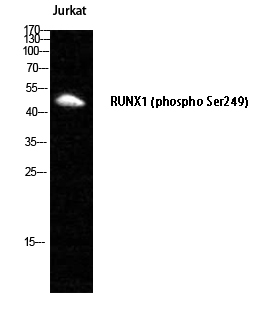
主要信息
Target
RUNX1
Host Species
Rabbit
Reactivity
Human, Mouse, Rat
Applications
WB, IHC, IF, ELISA
MW
50kD (Observed)
Conjugate/Modification
Unmodified

货号: YT4190
规格
价格
货期
数量
200μL
¥3,780.00
一个月
0
100μL
¥2,300.00
一个月
0
40μL
¥960.00
一个月
0
加入购物车


已收藏


收藏
详细信息
推荐稀释比
WB 1:500-1:2000; IHC 1:100-1:300; IF 1:200-1:1000; ELISA 1:20000; Not yet tested in other applications.
Note:For IHC,wesuggest antigen retrieval with TE buffer pH 9.0 (Cat#YS0004)
Note:For IHC,wesuggest antigen retrieval with TE buffer pH 9.0 (Cat#YS0004)
组成
Liquid in PBS containing 50% glycerol, 0.5% BSA and 0.02% sodium azide.
特异性
RUNX1 Polyclonal Antibody detects endogenous levels of RUNX1 protein.
纯化工艺
The antibody was affinity-purified from rabbit antiserum by affinity-chromatography using epitope-specific immunogen.
储存
-15°C to -25°C/1 year(Do not lower than -25°C)
浓度
1 mg/ml
实测条带
50kD
修饰
Unmodified
克隆性
Polyclonal
同种型
IgG
相关产品
抗原&靶点信息
免疫原:
The antiserum was produced against synthesized peptide derived from human AML1. AA range:269-318
展开内容
特异性:
RUNX1 Polyclonal Antibody detects endogenous levels of RUNX1 protein.
展开内容
基因名称:
RUNX1
展开内容
蛋白名称:
Runt-related transcription factor 1
展开内容
别名:
RUNX1 ;
AML1 ;
CBFA2 ;
Runt-related transcription factor 1 ;
Acute myeloid leukemia 1 protein ;
Core-binding factor subunit alpha-2 ;
CBF-alpha-2 ;
Oncogene AML-1 ;
Polyomavirus enhancer-binding protein 2 alpha B subunit ;
PEA2-alpha B ;
PEBP2-alpha
AML1 ;
CBFA2 ;
Runt-related transcription factor 1 ;
Acute myeloid leukemia 1 protein ;
Core-binding factor subunit alpha-2 ;
CBF-alpha-2 ;
Oncogene AML-1 ;
Polyomavirus enhancer-binding protein 2 alpha B subunit ;
PEA2-alpha B ;
PEBP2-alpha
展开内容
背景:
Core binding factor (CBF) is a heterodimeric transcription factor that binds to the core element of many enhancers and promoters. The protein encoded by this gene represents the alpha subunit of CBF and is thought to be involved in the development of normal hematopoiesis. Chromosomal translocations involving this gene are well-documented and have been associated with several types of leukemia. Three transcript variants encoding different isoforms have been found for this gene. [provided by RefSeq, Jul 2008],
展开内容
功能:
Alternative products:Additional isoforms seem to exist,Caution:The fusion of AML1 with EAP in T-MDS induces a change of reading frame in the latter resulting in 17 AA unrelated to those of EAP.,Disease:A chromosomal aberration involving RUNX1/AML1 is a cause of chronic myelogenous leukemia (CML). Translocation t(3;21)(q26;q22) with EAP, MSD1 or EVI1.,Disease:A chromosomal aberration involving RUNX1/AML1 is a cause of chronic myelomonocytic leukemia. Inversion inv(21)(q21;q22) with USP16.,Disease:A chromosomal aberration involving RUNX1/AML1 is a cause of M2 type acute myeloid leukemia (AML-M2). Translocation t(8;21)(q22;q22) with RUNX1T1/MTG8/ETO.,Disease:A chromosomal aberration involving RUNX1/AML1 is a cause of therapy-related myelodysplastic syndrome (T-MDS). Translocation t(3;21)(q26;q22) with EAP, MSD1 or EVI1.,Disease:A chromosomal aberration involving RUNX1/AML1 is found in childhood acute lymphoblastic leukemia (ALL). Translocation t(12;21)(p13;q22) with TEL. The translocation fuses the 3'-end of TEL to the alternate 5'-exon of AML-1H.,Disease:A chromosomal aberration involving RUNX1/AML1 is found in therapy-related myeloid malignancies. Translocation t(16;21)(q24;q22) that forms a RUNX1-CBFA2T3 fusion protein.,Disease:Defects in RUNX1 are the cause of familial platelet disorder with associated myeloid malignancy (FPDMM) [MIM:601399]. FPDMM is an autosomal dominant disease characterized by qualitative and quantitative platelet defects, and propensity to develop acute myelogenous leukemia.,Domain:A proline/serine/threonine rich region at the C-terminus is necessary for transcriptional activation of target genes.,Function:CBF binds to the core site, 5'-PYGPYGGT-3', of a number of enhancers and promoters, including murine leukemia virus, polyomavirus enhancer, T-cell receptor enhancers, LCK, IL-3 and GM-CSF promoters. The alpha subunit binds DNA and appears to have a role in the development of normal hematopoiesis. Isoform AML-1L interferes with the transactivation activity of RUNX1. Acts synergistically with ELF4 to transactivate the IL-3 promoter and with ELF2 to transactivate the mouse BLK promoter. Inhibits MYST4-dependent transcriptional activation.,PTM:Methylated.,PTM:Phosphorylated in its C-terminus upon IL-6 treatment. Phosphorylation enhances interaction with MYST3.,similarity:Contains 1 Runt domain.,subunit:Heterodimer with CBFB. RUNX1 binds DNA as a monomer and through the Runt domain. DNA-binding is increased by heterodimerization. Isoform AML-1L can neither bind DNA nor heterodimerize. Interacts with TLE1 and THOC4. Interacts with ELF1, ELF2 and SPI1. Interacts via its Runt domain with the ELF4 N-terminal region. Interaction with ELF2 isoform 2 (NERF-1a) may act to repress RUNX1-mediated transactivation. Interacts with MYST3 and MYST4. Interacts with SUV39H1, leading to abrogate the transactivating and DNA-binding properties of RUNX1.,tissue specificity:Expressed in all tissues examined except brain and heart. Highest levels in thymus, bone marrow and peripheral blood.,
展开内容
细胞定位:
Nucleus.
展开内容
组织表达:
Expressed in all tissues examined except brain and heart. Highest levels in thymus, bone marrow and peripheral blood.
展开内容
研究领域:
>>Tight junction ;
>>Th17 cell differentiation ;
>>Pathways in cancer ;
>>Transcriptional misregulation in cancer ;
>>Chronic myeloid leukemia ;
>>Acute myeloid leukemia
>>Th17 cell differentiation ;
>>Pathways in cancer ;
>>Transcriptional misregulation in cancer ;
>>Chronic myeloid leukemia ;
>>Acute myeloid leukemia
展开内容
信号通路
Cellular Processes >> Cellular community - eukaryotes >> Tight junction
Organismal Systems >> Immune system >> Th17 cell differentiation
Human Diseases >> Cancer: overview >> Pathways in cancer
Human Diseases >> Cancer: overview >> Transcriptional misregulation in cancer
Human Diseases >> Cancer: specific types >> Acute myeloid leukemia
Human Diseases >> Cancer: specific types >> Chronic myeloid leukemia
文献引用({{totalcount}})
货号: YT4190
规格
价格
货期
数量
200μL
¥3,780.00
一个月
0
100μL
¥2,300.00
一个月
0
40μL
¥960.00
一个月
0
加入购物车


已收藏


收藏
Recently Viewed Products
Clear allToggle night Mode
{{pinfoXq.title || ''}}
Catalog: {{pinfoXq.catalog || ''}}
Filter:
All
{{item.name}}
{{pinfo.title}}
-{{pinfo.catalog}}
主要信息
Target
{{pinfo.target}}
Reactivity
{{pinfo.react}}
Applications
{{pinfo.applicat}}
Conjugate/Modification
{{pinfo.coupling}}/{{pinfo.modific}}
MW (kDa)
{{pinfo.mwcalc}}
Host Species
{{pinfo.hostspec}}
Isotype
{{pinfo.isotype}}
产品 {{index}}/{{pcount}}
上一个产品
下一个产品
{{pvTitle}}
滚轮缩放图片
{{pvDescr}}



















